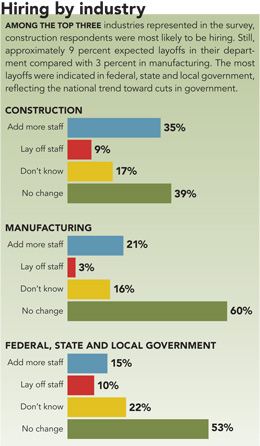Job Outlook 2012
Safety professionals say they need leadership and communication skills to succeed, in addition to technical know-how
KEY POINTS
- Almost 90 percent of respondents consider their job “very stable” or “relatively stable.”
- Safety leaders need to be able to speak the language of upper management and relate to workers.
- Safety professionals facing job insecurity say gaining additional skills and certifications may improve their odds of getting a new job.
If current trends hold steady, the number of occupational safety and health jobs will outpace the number of trained professionals to fill them, according to NIOSH. In a report issued last year, the agency warned of an upcoming shortage and highlighted additional skills employers wanted from new safety graduates. Leadership and communication topped the list.
Mastering those areas is crucial for experienced, as well as new, safety professionals, suggests findings from Safety+Health’s annual Job Outlook survey. The survey, conducted in May, was sent to 14,950 subscribers – 1,292 of whom responded for a response rate of 8.6 percent.
Asked to rank nine skills that safety professionals need in addition to industry-specific expertise, most respondents put communication with upper management, communication with workers/training, and leadership in the top three – an indication of both the importance and interrelatedness of those skill sets.
Consistent with last year, 87 percent of respondents consider their job “very stable” or “relatively stable.” Almost half of respondents work in manufacturing or construction, and more than one-third are managers. Regarding staffing, 23 percent have recently added staff to their department; one-quarter plan to hire in the next 12 months.
Looking down the road, the Bureau of Labor Statistics predicts that jobs for occupational safety and health specialists will grow at 9 percent (which is slower than average) through 2020, compared with 13 percent for occupational safety and health technicians.
BLS identified communication as an important quality for both groups, which lines up with survey responses.

Tom Schneid, director/chair of the graduate division of safety, security and emergency management at Eastern Kentucky University in Richmond, explained how communication functions on multiple levels. “I think critical and creative thinking is absolutely essential, and the ability to communicate with upper management to be able to justify your program, with middle management because those are the people you’re working with every day to get it done, and with your hourly workforce to integrate your programs and get them working on the shop floor,” he said.
In the pages that follow, survey respondents discuss their experience with communication and leadership and reflect on their personal career outlook.
Communication with upper management
When making the pitch to upper management, Patrick Genovese, risk management coordinator for DuPage County, IL, focuses on the financial impact.

“A person must be able to present in an executive-summary fashion their needs and how it’s going to affect the company’s ROI,” he said. “If they’re not able to be a good presenter in front of the board, suit and tie, they’re not going to be successful getting buy-in to the program, nor the money for training.”
Genovese believes safety professionals also need public speaking skills to address large groups, although they should not do all the talking during day-to-day interactions with workers.
“Being a good listener is very, very important, and being able to be a good investigator – to have your eyes and ears open all the time,” he added.
Stephen Frost, quality/environmental health and safety coordinator at Jupiter, FL-based PSM, which makes aftermarket gas turbines, said both upper management and workers want to prevent injuries, but management may not realize its message is coming across as “get it done regardless of safety,” and workers may need education on identifying hazards.
That is where he comes in, Frost said, “teaching them to communicate better from the top down and teaching the employees to pay attention to what they’re doing and communicate back up to management saying, ‘Hey, this is a dangerous situation. How can we overcome the hazards that are created?’”
Post a comment to this article
Safety+Health welcomes comments that promote respectful dialogue. Please stay on topic. Comments that contain personal attacks, profanity or abusive language – or those aggressively promoting products or services – will be removed. We reserve the right to determine which comments violate our comment policy. (Anonymous comments are welcome; merely skip the “name” field in the comment box. An email address is required but will not be included with your comment.)

